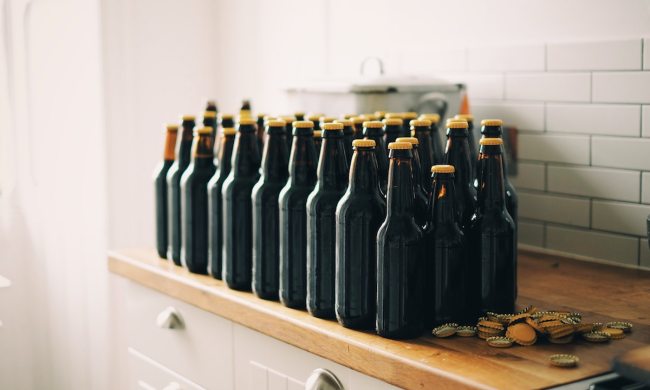In the foothills of Texas, a short drive outside Austin, Treaty Oak Distilling loves to play with booze on their sprawling 28-acre campus. Phillip Dormont, Treaty Oak’s director of product development, has a long list of experiments going at any given time. Ranging from distillation to barrel wood to cocktails, Dormont is a mad scientist of sorts.

Since 2006, Treaty Oak has been making booze in Texas and now the distillery’s line of whiskeys and gins are supplemented by a long list of experiments rolling out at the property’s several bars. Without an open mind from Treaty Oak founder and CEO Daniel Barnes, it could be a lot less interesting in Texas.
“The most important things I can offer as a leader is a collaborative environment and the appropriate tools for success,” Barnes said. “Emotion is contagious, and creativity has definitely become an infectious feeling at Treaty Oak. Phillip is one of the many creative people that have been able to flourish at Treaty Oak, not to mention others involved in distilling, cocktails, cooking, the look and feel of our branding – the list goes on.”
Phillip is one of the many creative people that have been able to flourish at Treaty Oak, not to mention others involved in distilling, cocktails, cooking, the look and feel of our branding – the list goes on.
Currently, Dormont is focusing mostly on dialing in recipes, especially now that the distillery recently installed a new column still from Vendome, but walking around the campus’ dirt paths around thick oak trees he’ll point out experiments pretty much everywhere.
“It’s good and chaotic all in one,” Dormont said of his experiments. “There’s so much going on and you get pulled in so many directions, but with that comes a huge plethora of final products you get later on. My whole day is dedicated to bettering the process and creating new things.”
On the cocktail front, Dormont has pushed some strange boundaries. Whether it’s simply gathering Texas ingredients from the Treaty Oak property or making a Dirt Martini using a dirt distillate or a clarified Bloody Mary, he has fun behind the bar.
Likewise, Treaty Oak distillers are having fun with the brand’s gin line. There are currently three, the Waterloo No. 9 Gin, Waterloo Antique Gin, and Waterloo Old Yaupon Gin. The Old Yaupon Gin plays tribute to botanicals of Texas, like honey from the yaupon, a holly tree with natural caffeine. Dormont said he’s also working on California and Florida gins. The Treaty Oak team also introduced a Guajillo pepper-infused Antique Gin.
“These regional gins are highlighting certain ingredients that are part of the culture and native botany,” he said, also noting the project is on hold while the column still gets fully situated.

It’s the whiskey side that can be the most exciting at Treaty Oak, as is the trend in spirits these days.
As with many distilleries, Treaty Oak started with a sourced whiskey, but the Texas company has been transparent about its usage and has its own line with the tongue-in-cheek name “Red Handed.” The series prominently features on the front label where the liquid was distilled. Currently Treaty Oak has its straight Red Handed Bourbon and a 10 Year Red Handed Rye. In addition, Dormont mentioned the existence of port- and Madeira-finished Red Handed whiskeys.
There are as many varieties of corn as there are grapes and I find it fascinating people put so much emphasis on varietals in wine but don’t put the effort in specialty corn.
But it’s Treaty Oak’s own whiskey providing some of the most exciting experiments. Treaty Oak has already released Ghost Hill Texas Bourbon, but there’s plenty more in store. The distillery is partnering with Texas grain broker James Brown, even selling him two acres of the property, to help lead the charge of bringing back antique and heirloom grains.
Dormont said Treat Oak has experimented with a variety of heirloom corn, like Bloody Butcher, Hickory King, Green Oaxaca, and Jimmy Red. He said they’ll try to do four new grains a year, as they take time to develop, before figuring out which ones to fully integrate into their portfolio.
Whiskey made with Bloody Butcher corn, according to Dormont, is earthier than bourbon’s traditional No. 2 Dent corn, while Hickory King is sweeter with bright creamy notes in both mouthfeel and flavor.
“There are as many varieties of corn as there are grapes and I find it fascinating people put so much emphasis on varietals in wine but don’t put the effort in specialty corn,” Dormont said. “That’s what inspired me to put a lot into it. The trend is moving that way, it’s not like we’re the only ones doing it, but not very many people have an asset like James Brown.”

After whiskeys are done aging in the barrels, Treaty Oak utilizes a reuse program, throwing in maple syrup, hot sauce, honey, and cold brew coffee — some of which end up on the site’s Alice’s Restaurant.
It’s those barrels that provide Treaty Oak with a lot of options. The main objective right now is figuring out definitively how the Texas climate ages whiskey compared to traditional whiskey-producing regions like Kentucky and Scotland.
From the rick house to burying six barrels six feet underground in a “graveyard series,” it’s all about figuring out how the Texas air affects how the whiskey plays interacts with the wood.
Treaty Oak is also embarking on a Texas oak barrel program. The distillery partnered with a Texas wood mill to use oaks from development sites to make barrels.
For all the experiments and use of Texas ingredients, Treaty Oak employees won’t sacrifice quality.
“We do what we can,” Dormont said. “We aren’t willing to sacrifice quality to have it be Texas. There comes a point it doesn’t make sense and we’re cognizant about that.”


